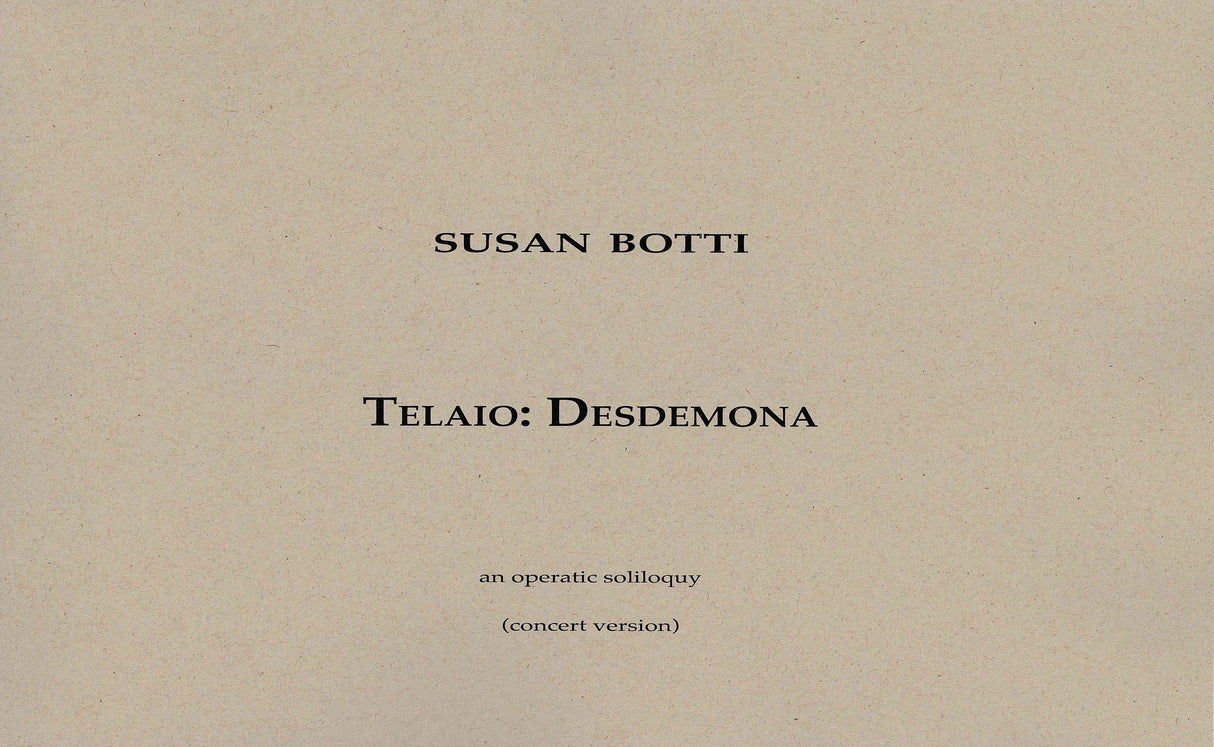Botti: Talaio: Desdemona (Concert Version)
Expected to ship in 1-2 weeks.
- Composer: Susan Botti (1962-)
- Format: Full Score
- Instrumentation: Soprano, Chamber Ensemble
- Work: Telaio: Desdemona (1995)
- Binding: Spiral Bound
- Work Languages: English, Italian
- Size: 14.0 x 8.5 inches
Description
Telaio: Desdemona is an operatic soliloquy - a character study of Shakespeare's Desdemona from Othello, the tragic story of jealousy and betrayal. Set in Venice and on the island of Cyprus, the play depicts the intense love between the exotic Moor, Othello, and the Venetian lady, Desdemona, their subsequent elopement, and finally the unraveling of their love through the manipulations of Othello's standard-bearer, Iago. Unable to tolerate Iago's insinuations about Desdemona's fidelity, Othello strangles his wife despite her protestations of innocence.
The soloist performs two "roles": the narrator and "Desdemona." The narrator, in recitatives, describes Desdemona through a collage of texts from Othello which are second-hand descriptions of her personality, words, and/or actions (originally spoken by other characters in the play). in arias, the character of Desdemona speaks through the poetry of an Italian Renaissance woman, Gaspara Stampa, and in traditional Italian folksong.
For the recitatives, the music is driven by the words, and the instrumentation focuses on the piano, harp, and percussion. in contrast, the arias are more emotional and lyrical and are accompanied by the string quartet.
The Italian word "telaio" literally means "frame"- as in the frame of a loom used for weaving. Telaio: Desdemona explores this image in several ways. First, the entire piece serves as a frame within which threads of the character of Desdemona are woven, and out of which her portrait emerges. Secondly, I have used the traditional forms of recitative and aria to serve as a series of smaller frames within the overall structure. Lastly, the word "telaio" is a pun - in Shakespeare's Othello, Desdemona is in essence "framed" by Iago.
Instrumentation: soprano, string quartet, harp, piano, percussion
Publishers use a lot of words to describe what they sell, and we know it can be confusing. We've tried to be as clear as possible to make sure you get exactly what you are looking for. Below are descriptions of the terms that we use to describe the various formats that music often comes in.
Choral Score
A score for vocalists that only contains the vocal lines. The instrumental parts are not there for reference. Generally, cheaper than a vocal score and requires multiple copies for purchase.
Facsimile
Reproductions of the original hand-written scores from the composer.
Full Score
For ensemble music, this indicates that the edition contains all parts on a single system (there are not separate parts for each player). In larger ensembles, this is for the conductor.
Hardcover
Hardbound. Generally either linen-covered or half-leather.
Orchestral Parts
Similar to a wind set, this is a collection of parts. In the case of strings, the numbers listed are the number of copies included, though generally these are available individually (often with minimum quantities required).
Paperback
When publishers offer multiple bindings (e.g. hardcover) or study scores, this is the "standard" version. If you're planning to play the music, this is probably what you want.
Performance / Playing Score
A score of the music containing all parts on one system, intended for players to share. There are not separate parts for each player.
Set of Parts
For ensemble music, this indicates that there are separate individual parts for each player.
Solo Part with Piano Reduction
For solo pieces with orchestra, this is a version that contains a piano reduction of the orchestra parts. For piano pieces, two copies are typically needed for performance.
Study Score
A small (think choral size) copy of the complete score meant for studying, and not playing. They make great add-ons when learning concertos and small chamber works.
Vocal Score
A score prepared for vocalists that includes the piano/organ part or a reduction of the instrumental parts.
Wind Set
For orchestral music, this is a collection of wind and percussion parts. The specific quantities of each instrument are notated.
With Audio
In addition to the printed music, the edition contains recordings of the pieces. This may be an included CD, or access to files on the internet.
With / Without Fingering (Markings)
Some publishers prepare two copies - a pure Urtext edition that includes no fingering (or bowing) suggestions and a lightly edited version that includes a minimal number of editorial markings.


